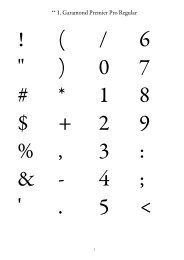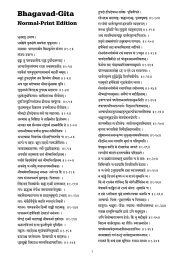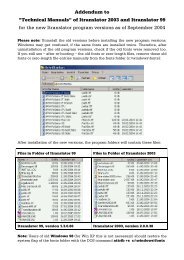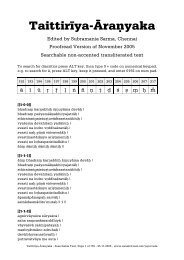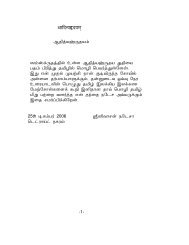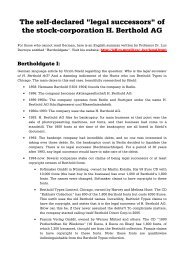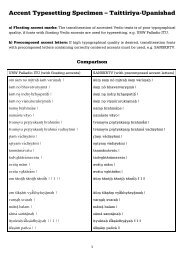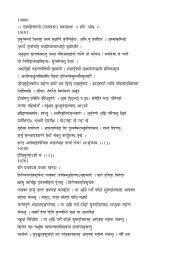- Page 1 and 2:
Note Arthur Berriedale Keith (1879-
- Page 3 and 4:
CONTENTS OF TRANSLATION [[Kanda 1]]
- Page 5 and 6:
5. The Mantras for the adoration of
- Page 7 and 8:
13. Offering for one seized by misf
- Page 9 and 10:
1. The introductory rite of the new
- Page 11 and 12:
10. The Vasor Dhara offerings 11. T
- Page 13 and 14:
12. List of eighteen victims 13. Li
- Page 15 and 16:
9. The cup for the yoker of the bay
- Page 17 and 18:
17. The Gavya Mantras 18. The riddl
- Page 19 and 20:
I Be ye united, that follow holy or
- Page 21 and 22:
a I grasp (thee). b Thou art Indra'
- Page 23 and 24:
[[1-1-13]] a With the impulse of st
- Page 25 and 26:
g Thou art the body of Soma, guard
- Page 27 and 28:
e Thus I cut the neck of him who ha
- Page 29 and 30:
d Agni, lord of vows, thou art the
- Page 31 and 32:
O Hotr, most youthful, skilful, fri
- Page 33 and 34:
May he go before us cleaving the fo
- Page 35 and 36:
a Let thy speech swell, let thy bre
- Page 37 and 38:
He blazeth with his light within th
- Page 39 and 40:
and earth thee! c May mind enter th
- Page 41 and 42:
[[1-4-14]] a Thou art Madhu and Mad
- Page 43 and 44:
[[1-4-27]] a Of thee, O drop, press
- Page 45 and 46:
a Great is Indra of the Sodaçin, W
- Page 47 and 48:
[[1-4-46]] a I who deeming thee imm
- Page 49 and 50:
And the father, faring to the heave
- Page 51 and 52:
a I gaze on offspring, Offspring of
- Page 53 and 54:
makes it productive by the morning
- Page 55 and 56:
i Thine anger, O Varuna, would we a
- Page 57 and 58:
a May I Agni protect me from evil s
- Page 59 and 60:
Far away drive ill-fortune. m O Agn
- Page 61 and 62:
verses he should first insert the V
- Page 63 and 64:
Smash the jaws of Vrtra; In rage do
- Page 65 and 66:
the sacrifice on both sides [2], in
- Page 67 and 68:
a On the instigation of the god Sav
- Page 69 and 70:
a Thou art taken with a support; th
- Page 71 and 72:
[[1-8-2]] He offers to Agni on eigh
- Page 73 and 74:
a (He I offers) to Indra and Agni o
- Page 75 and 76:
l Protect me in front, protect me a
- Page 77 and 78:
the Saman of the Brahman is the Çr
- Page 79 and 80:
[[KANDA 2]] PRAPATHAKA I The Specia
- Page 81 and 82:
thunderbolt. Verily he has recourse
- Page 83 and 84:
two forms. The third (sap) which fe
- Page 85 and 86:
Indra and Parvata quicken us; May t
- Page 87 and 88:
active; he should offer in (a place
- Page 89 and 90:
months; the birthplace of Agni is t
- Page 91 and 92:
each of the Puronuvakyas, for speci
- Page 93 and 94:
e Up that. f The radiant. g Thou fr
- Page 95 and 96:
attained', they say; of the dark on
- Page 97 and 98:
worse, that is (the origin) of the
- Page 99 and 100:
[[2-3-11]] To Agni his body goes, t
- Page 101 and 102:
Brhaspati drove out the cows, which
- Page 103 and 104:
with their own share; verily they p
- Page 105 and 106:
'O gods having wealth, O gods grant
- Page 107 and 108:
Boisterous and brave, waxeth great
- Page 109 and 110:
are in the cow; ghee indeed is the
- Page 111 and 112:
new and the full moon are the strid
- Page 113 and 114:
Agni, bring Agni hither, bring Soma
- Page 115 and 116:
The pure waters stand. r The auster
- Page 117 and 118:
ehind [3]; verily he defeats the en
- Page 119 and 120:
Agni had three elder brothers; they
- Page 121 and 122:
found him by the offerings in the a
- Page 123 and 124:
[[2-6-12]] a Eagerly we hail thee,
- Page 125 and 126:
[[KANDA 3]] PRAPATHAKA I The Supple
- Page 127 and 128:
k O ye slayers, come To the sacrifi
- Page 129 and 130:
May Agni protect us at the morning
- Page 131 and 132:
Reveal, O goddess, offspring unto u
- Page 133 and 134:
sacrifice, but could not get on its
- Page 135 and 136:
Of mortal man do to us, O immortal?
- Page 137 and 138:
Whom the fires of the hearths did t
- Page 139 and 140:
[[3-2-11]] a He by thy help, O Agni
- Page 141 and 142:
Radiance confer on me, O ye Açvins
- Page 143 and 144:
That houses fail us not. e Do thou
- Page 145 and 146:
Life in days to come and unfailing;
- Page 147 and 148:
all the deities are Prajapati; veri
- Page 149 and 150:
order his oblation, and the kingdom
- Page 151 and 152:
Eagle of vultures, axe of the fores
- Page 153 and 154:
propagated with Vasistha as their P
- Page 155 and 156:
a I yoke thee with milk, with ghee;
- Page 157 and 158:
To bear the oblation [1]. e O Agni
- Page 159 and 160:
[[4-1-1]] [[KANDA 4]] THE PILING OF
- Page 161 and 162:
Plants with fair leaves. r I touch
- Page 163 and 164:
l O plants, do ye accept Agni here
- Page 165 and 166:
Slaying our rivals, conquering the
- Page 167 and 168:
Be firm and enduring; O mother, dar
- Page 169 and 170:
i Impeller of righteousness, Instig
- Page 171 and 172:
Thee standing in the third region [
- Page 173 and 174:
To the gods thou speakest, those of
- Page 175 and 176:
[[4-2-6]] a The plants born Three g
- Page 177 and 178:
In thee have they placed food, rich
- Page 179 and 180:
With all of these grant us brillian
- Page 181 and 182:
o In every contest. In the waters,
- Page 183 and 184:
a (Thou art) the calf of eighteen m
- Page 185 and 186:
What time he produced sisters of th
- Page 187 and 188:
May they from us unloosen the bonds
- Page 189 and 190:
weapon the Raksases. b This on the
- Page 191 and 192:
Of noble resolve, of true inspirati
- Page 193 and 194:
Naksatra, the All-gods the deity;
- Page 195 and 196:
The Offerings to Rudra [[4-5-1]] a
- Page 197 and 198:
c Homage to you sharpers, and to yo
- Page 199 and 200:
Homage to the intelligent. s Homage
- Page 201 and 202:
Pure in hue and auspicious. g Pure,
- Page 203 and 204:
The lord of streams, homage! To the
- Page 205 and 206: Let the sound of the conquering cha
- Page 207 and 208: Trampling with their forefeet the e
- Page 209 and 210: [[4-6-8]] a Let not Mitra, Varuna,
- Page 211 and 212: adiance, play, delight, what is bor
- Page 213 and 214: United suckle one child; The radian
- Page 215 and 216: a Of Agni first I reckon, the wise
- Page 217 and 218: [[KANDA 5]] THE EXPLANATION OF THE
- Page 219 and 220: 'On the instigation of the god Savi
- Page 221 and 222: he says; the Dhisanas are the scien
- Page 223 and 224: gazes; verily he declares his great
- Page 225 and 226: makes him attain his own place of b
- Page 227 and 228: 'O Agni, strength and fame are thin
- Page 229 and 230: pan he puts (it) down; verily he ma
- Page 231 and 232: e May the earth with the atmosphere
- Page 233 and 234: 'Thou art the portion of Agni', (wi
- Page 235 and 236: (sky); verily he puts down yonder (
- Page 237 and 238: the Naksatras are the lights of the
- Page 239 and 240: 'Do thou lead him forward', (with t
- Page 241 and 242: Udumbara is strength, food is stren
- Page 243 and 244: hooves that of sheep, that it is a
- Page 245 and 246: having put down the second [2] he s
- Page 247 and 248: g May speech be mine in the mouth,
- Page 249 and 250: For the sun the crane; the deer, th
- Page 251 and 252: He draws cups of water; the cups ar
- Page 253 and 254: were to step on it, he would hand h
- Page 255: Again the Viraj has ten elements, t
- Page 259 and 260: Thence was born the kingly power, m
- Page 261 and 262: O All-gods, sit ye with the sacrifi
- Page 263 and 264: Tortoises with the hooves; with the
- Page 265 and 266: [[6-1-1]] [[KANDA 6]] THE EXPLANATI
- Page 267 and 268: Whatever is imbued in those two, he
- Page 269 and 270: course of the sacrifice. Now if he
- Page 271 and 272: Garhapatya fire is piled up; for yo
- Page 273 and 274: not yet arrived. One ox is unyoked,
- Page 275 and 276: the gods in the form of Visnu, and
- Page 277 and 278: [[6-2-8]] The high altar said, 'Thr
- Page 279 and 280: him he thus casts out. He unites th
- Page 281 and 282: cattle. He should cut one that is s
- Page 283 and 284: [[6-3-7]] By means of Agni as Hotr
- Page 285 and 286: performs (ávadayate) by these cutt
- Page 287 and 288: The theologians say, 'He indeed wou
- Page 289 and 290: 'Let me choose a boon; let your cup
- Page 291 and 292: he chooses the Udgatrs; the Agrayan
- Page 293 and 294: Aditi, desirous of offspring, cooke
- Page 295 and 296: Offspring and cattle are born throu
- Page 297 and 298: six, the seasons are six [3]; veril
- Page 299 and 300: Indra, splendour by that for Surya.
- Page 301 and 302: [[7-1-1]] [[KANDA 7]] THE EXPLANATI
- Page 303 and 304: moved.' The Ajya (Çastra) of the m
- Page 305 and 306: Jamadagni desiring prosperity, sacr
- Page 307 and 308:
To Agni hail! To Soma hail! To Savi
- Page 309 and 310:
To him going out hail! To him who h
- Page 311 and 312:
them, and thus they are ahungered;
- Page 313 and 314:
and Vayu is connected with the Rath
- Page 315 and 316:
To fifteen hail! To seventeen hail!
- Page 317 and 318:
To him that will rise hail! To the
- Page 319 and 320:
[1], by (the rite) of fifteen night
- Page 321 and 322:
The libation, the Ida, the prayers,
- Page 323 and 324:
To the glossy and variegated one ha
- Page 325 and 326:
verily with them do they [2] procee
- Page 327 and 328:
imperfectly, and their speech would
- Page 329 and 330:
[[7-4-12]] a Let the ram aid thee w
- Page 331 and 332:
What is a remedy for the cold? What
- Page 333 and 334:
who knowing thus perform the year (
- Page 335 and 336:
their several places. (They offer t
- Page 337 and 338:
To that which thundereth hail! To t
- Page 339 and 340:
Now for the fire which is produced
- Page 341:
[[7-5-25]] He who knows the head of


![[[1-1-1]] [[Book-Chapter-Paragraph]] - Sanskrit Web](https://img.yumpu.com/25993632/256/500x640/1-1-1-book-chapter-paragraph-sanskrit-web.jpg)



